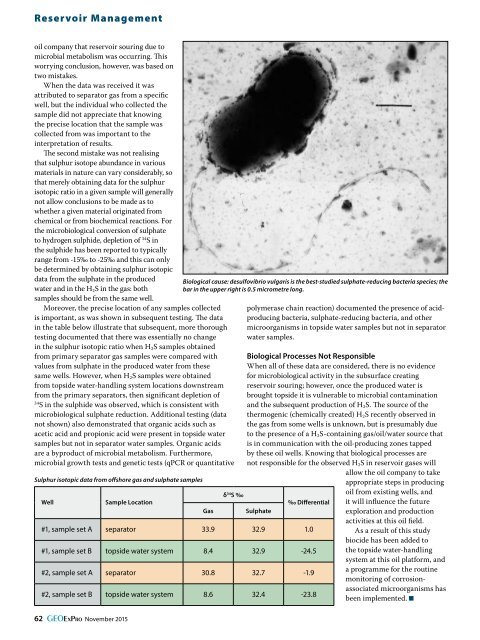Iraqi Kurdistan All in the Timing
GEO_ExPro_v12i6
GEO_ExPro_v12i6
You also want an ePaper? Increase the reach of your titles
YUMPU automatically turns print PDFs into web optimized ePapers that Google loves.
Reservoir Management<br />
oil company that reservoir sour<strong>in</strong>g due to<br />
microbial metabolism was occurr<strong>in</strong>g. This<br />
worry<strong>in</strong>g conclusion, however, was based on<br />
two mistakes.<br />
When <strong>the</strong> data was received it was<br />
attributed to separator gas from a specific<br />
well, but <strong>the</strong> <strong>in</strong>dividual who collected <strong>the</strong><br />
sample did not appreciate that know<strong>in</strong>g<br />
<strong>the</strong> precise location that <strong>the</strong> sample was<br />
collected from was important to <strong>the</strong><br />
<strong>in</strong>terpretation of results.<br />
The second mistake was not realis<strong>in</strong>g<br />
that sulphur isotope abundance <strong>in</strong> various<br />
materials <strong>in</strong> nature can vary considerably, so<br />
that merely obta<strong>in</strong><strong>in</strong>g data for <strong>the</strong> sulphur<br />
isotopic ratio <strong>in</strong> a given sample will generally<br />
not allow conclusions to be made as to<br />
whe<strong>the</strong>r a given material orig<strong>in</strong>ated from<br />
chemical or from biochemical reactions. For<br />
<strong>the</strong> microbiological conversion of sulphate<br />
to hydrogen sulphide, depletion of 34 S <strong>in</strong><br />
<strong>the</strong> sulphide has been reported to typically<br />
range from -15‰ to -25‰ and this can only<br />
be determ<strong>in</strong>ed by obta<strong>in</strong><strong>in</strong>g sulphur isotopic<br />
data from <strong>the</strong> sulphate <strong>in</strong> <strong>the</strong> produced<br />
water and <strong>in</strong> <strong>the</strong> H 2 S <strong>in</strong> <strong>the</strong> gas: both<br />
samples should be from <strong>the</strong> same well.<br />
Moreover, <strong>the</strong> precise location of any samples collected<br />
is important, as was shown <strong>in</strong> subsequent test<strong>in</strong>g. The data<br />
<strong>in</strong> <strong>the</strong> table below illustrate that subsequent, more thorough<br />
test<strong>in</strong>g documented that <strong>the</strong>re was essentially no change<br />
<strong>in</strong> <strong>the</strong> sulphur isotopic ratio when H 2 S samples obta<strong>in</strong>ed<br />
from primary separator gas samples were compared with<br />
values from sulphate <strong>in</strong> <strong>the</strong> produced water from <strong>the</strong>se<br />
same wells. However, when H 2 S samples were obta<strong>in</strong>ed<br />
from topside water-handl<strong>in</strong>g system locations downstream<br />
from <strong>the</strong> primary separators, <strong>the</strong>n significant depletion of<br />
34<br />
S <strong>in</strong> <strong>the</strong> sulphide was observed, which is consistent with<br />
microbiological sulphate reduction. Additional test<strong>in</strong>g (data<br />
not shown) also demonstrated that organic acids such as<br />
acetic acid and propionic acid were present <strong>in</strong> topside water<br />
samples but not <strong>in</strong> separator water samples. Organic acids<br />
are a byproduct of microbial metabolism. Fur<strong>the</strong>rmore,<br />
microbial growth tests and genetic tests (qPCR or quantitative<br />
Sulphur isotopic data from offshore gas and sulphate samples<br />
Well<br />
Sample Location<br />
Biological cause: desulfovibrio vulgaris is <strong>the</strong> best-studied sulphate-reduc<strong>in</strong>g bacteria species; <strong>the</strong><br />
bar <strong>in</strong> <strong>the</strong> upper right is 0.5 micrometre long.<br />
δ 34 S ‰<br />
#1, sample set A separator 33.9 32.9 1.0<br />
#1, sample set B topside water system 8.4 32.9 -24.5<br />
#2, sample set A separator 30.8 32.7 -1.9<br />
#2, sample set B topside water system 8.6 32.4 -23.8<br />
Gas<br />
polymerase cha<strong>in</strong> reaction) documented <strong>the</strong> presence of acidproduc<strong>in</strong>g<br />
bacteria, sulphate-reduc<strong>in</strong>g bacteria, and o<strong>the</strong>r<br />
microorganisms <strong>in</strong> topside water samples but not <strong>in</strong> separator<br />
water samples.<br />
Biological Processes Not Responsible<br />
When all of <strong>the</strong>se data are considered, <strong>the</strong>re is no evidence<br />
for microbiological activity <strong>in</strong> <strong>the</strong> subsurface creat<strong>in</strong>g<br />
reservoir sour<strong>in</strong>g; however, once <strong>the</strong> produced water is<br />
brought topside it is vulnerable to microbial contam<strong>in</strong>ation<br />
and <strong>the</strong> subsequent production of H 2 S. The source of <strong>the</strong><br />
<strong>the</strong>rmogenic (chemically created) H 2 S recently observed <strong>in</strong><br />
<strong>the</strong> gas from some wells is unknown, but is presumably due<br />
to <strong>the</strong> presence of a H 2 S-conta<strong>in</strong><strong>in</strong>g gas/oil/water source that<br />
is <strong>in</strong> communication with <strong>the</strong> oil-produc<strong>in</strong>g zones tapped<br />
by <strong>the</strong>se oil wells. Know<strong>in</strong>g that biological processes are<br />
not responsible for <strong>the</strong> observed H 2 S <strong>in</strong> reservoir gases will<br />
allow <strong>the</strong> oil company to take<br />
appropriate steps <strong>in</strong> produc<strong>in</strong>g<br />
oil from exist<strong>in</strong>g wells, and<br />
‰ Differential it will <strong>in</strong>fluence <strong>the</strong> future<br />
Sulphate<br />
exploration and production<br />
activities at this oil field.<br />
As a result of this study<br />
biocide has been added to<br />
<strong>the</strong> topside water-handl<strong>in</strong>g<br />
system at this oil platform, and<br />
a programme for <strong>the</strong> rout<strong>in</strong>e<br />
monitor<strong>in</strong>g of corrosionassociated<br />
microorganisms has<br />
been implemented.<br />
62 GEOExPro November 2015


